History
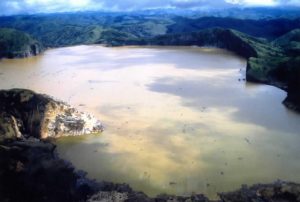 Natural disasters happen all the time…every day for that matter. Many of these disasters cannot be predicted, or can only be predicted a few minutes to hours before the disaster arrives. That was not the case with the Limnic eruption that happened at Lake Nyos in Cameroon, on August 21, 1986…or was it. A Limnic eruption is a eruption of gas rather than lava or ash, and the gasses can be deadly.
Natural disasters happen all the time…every day for that matter. Many of these disasters cannot be predicted, or can only be predicted a few minutes to hours before the disaster arrives. That was not the case with the Limnic eruption that happened at Lake Nyos in Cameroon, on August 21, 1986…or was it. A Limnic eruption is a eruption of gas rather than lava or ash, and the gasses can be deadly.
The eruption of lethal gas came from Lake Nyos at 9:30pm on that August day in 1986, took the lives of 2,000 people in the nearby villages, including Lower Nyos. The eruption wiped out four villages too. Carbon Dioxide, while natural to the earth, and even a part of the life process, becomes deadly if there is too much of it. Because Lake Nyos and Lake Monoun are crater lakes, the possibility exists for gasses to escape from the volcanos below them. The lakes are both about a mile square, and are located in the remote mountains of northwestern Cameroon. The area is beautiful with great rock cliffs and lush green vegetation.
Prior to the eruption, there were signs of impending disaster. In August 1984, 37 people near Lake Monoun died suddenly, but the incident was largely covered up by the government. The remoteness and lack of services made the incidents easier to cover up. Since there is no electricity or telephone service in the area, it was not difficult to keep the incident under wraps, and the 5,000 people who lived in villages near Lake Nyos simply had no idea that there was a very real danger of their own lake producing the same dangerous gas. I’m not 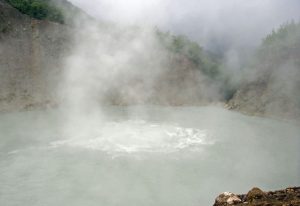 certain why they would want to keep the matter a secret, other that to avoid causing a panic, but the plan was fraught with disaster. Had the people known, maybe they could have left the area and survived.
certain why they would want to keep the matter a secret, other that to avoid causing a panic, but the plan was fraught with disaster. Had the people known, maybe they could have left the area and survived.
When scientists first began to be able to predict natural disasters, they were afraid the tell people that there was a problem. Then, after many people lost their lives from what could have been an avoidable disaster, most governments began to see the value of early warnings. The 37 people who lost their lives had no chance of a warning. There were no signs of that eruption, but if the government hadn’t hidden the facts, the 2,000 people who died when lake Nyos had its eruption, might have had a chance. At the very least, they could have made an educated decision about whether to stay or to go. Of course, with two years between the eruptions, they might have ignored the warnings too.
When the rumbling noise from the lake began at 9:30pm, and continued for 15 to 20 seconds, followed by a cloud of carbon-dioxide, and a blast of smelly air, it was too late for those people. The cloud quickly moved north toward the village of Lower Nyos. Some people tried to run away from the cloud, but they were later found dead on the paths leading away from town. The only two survivors of Lower Nyos were a woman and a child. The deadly cloud of gas continued on to Cha Subum and Fang, where another 500 people lost their lives. The carbon dioxide killed every type of animal, including small insects, in its path, but left buildings and plants unaffected, because plants use carbon dioxide as part of the growth cycle.
Reportedly, even survivors experienced coughing fits and vomited blood. Outsiders only learned of the disaster  as they approached the villages and found animal and human bodies on the ground. The best estimate is that 1,700 people and thousands of cattle died. A subsequent investigation of the lake showed the water level to be four feet lower than what it had previously been. Apparently, carbon dioxide had been accumulating from underground springs and was being held down by the water in the lake. When the billion cubic yards of gas finally burst out, it traveled low to the ground–it is heavier than air–until it dispersed. Lake Nyos must now be constantly monitored for carbon-dioxide accumulation. Hopefully that will prevent further disasters like these from happening again.
as they approached the villages and found animal and human bodies on the ground. The best estimate is that 1,700 people and thousands of cattle died. A subsequent investigation of the lake showed the water level to be four feet lower than what it had previously been. Apparently, carbon dioxide had been accumulating from underground springs and was being held down by the water in the lake. When the billion cubic yards of gas finally burst out, it traveled low to the ground–it is heavier than air–until it dispersed. Lake Nyos must now be constantly monitored for carbon-dioxide accumulation. Hopefully that will prevent further disasters like these from happening again.
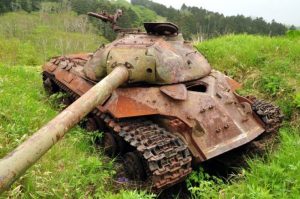 War machines…the weapons of war…everything from tanks to airplanes to ships. A war cannot be fought without the equipment that transports, shoots, bombs, floats, and flies over the war. What happens to the shattered remains of the equipment that didn’t make it back to base? Obviously, if a ship is hit, it ends up at the bottom of the ocean, as does a submarine, but what of the planes, tanks, jeeps, and even the bases that have been bombed out, shot up, or otherwise rendered useless? The world is littered with the wreckage of the many wars that have taken place over the years of human existence, because humans have a propensity for fighting. We don’t like when things don’t go our way, and if we don’t understand that we can’t always have it our way, we tend to go to war.
War machines…the weapons of war…everything from tanks to airplanes to ships. A war cannot be fought without the equipment that transports, shoots, bombs, floats, and flies over the war. What happens to the shattered remains of the equipment that didn’t make it back to base? Obviously, if a ship is hit, it ends up at the bottom of the ocean, as does a submarine, but what of the planes, tanks, jeeps, and even the bases that have been bombed out, shot up, or otherwise rendered useless? The world is littered with the wreckage of the many wars that have taken place over the years of human existence, because humans have a propensity for fighting. We don’t like when things don’t go our way, and if we don’t understand that we can’t always have it our way, we tend to go to war.
On an island in the North Pacific, lies a remote island called Shikotan, at the southern end of the Kuril archipelago. The island seems like a simple place, green and lush in the summertime, but the island hides a secret. It has one particularly astonishing characteristic. The island is dotted with the decaying hulks of Russian 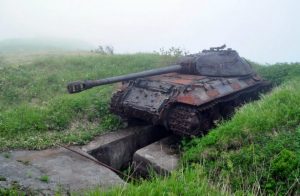 military tanks from the 1950s. And these rusting relics hint at the troubled past…and present of Shikotan. Shikotan is a part of an ongoing battle for ownership between Russia and Japan.
military tanks from the 1950s. And these rusting relics hint at the troubled past…and present of Shikotan. Shikotan is a part of an ongoing battle for ownership between Russia and Japan.
Shikotan is part of the Kuril archipelago, a chain of islands stretching from the southeastern tip of Russia to the north of the Japanese island of Hokkaido. The Pacific lies on one side of the Kuril Islands, with the Sea of Okhotsk found on the other. Its location makes it an important island to both countries, hence the battle. After World War II, the San Francisco Peace Treaty, which was signed between the Allies and Japan in 1951, stated that Japan must give up “all right, title and claim to the Kuril Islands.” Unfortunately, it didn’t specifically recognize the Soviet Union’s sovereignty over them. That allowed the dispute that has ensued. Japan claims that at least some of the disputed islands are not a part of the Kuril Islands, and thus are not covered by the treaty. Russia maintains that the Soviet Union’s sovereignty over the islands was recognized in post-war agreements.
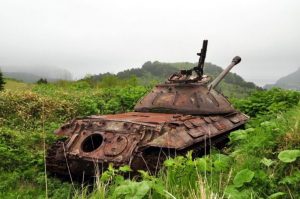
Since that time, Japan and the Soviet Union had been fighting over the island. They finally ended their formal state of war with the Soviet–Japanese Joint Declaration of 1956, but did not resolve the territorial dispute. During talks leading to the joint declaration, the Soviet Union offered Japan the two smaller islands of Shikotan and the Habomai Islands in exchange for Japan renouncing all claims to the two bigger islands of Iturup and Kunashir, but Japan refused the offer after pressure from the US. Japan did not really intend to give up the island, and no one really knows how strong their army there was, but what is left on the island are the remnants of that army…a few masterpieces of Soviet engineering, IS-2 and IS-3 tanks.

 It seems like these days, the more unique a motorcycle is, the more attention it gets. I don’t think anyone who as seen an unusual motorcycle, can say that they weren’t impressed, amused, or just shocked. You can’t really believe what you are seeing, but it’s hard to look away too. I sometimes wonder how these people came up with such an idea. I guess it takes a great deal of imagination. Some of these designs, are hilarious, and there is seriously no other word for it. People just think of something that is important in their lives, and turn their motorcycle into so version of that thing.
It seems like these days, the more unique a motorcycle is, the more attention it gets. I don’t think anyone who as seen an unusual motorcycle, can say that they weren’t impressed, amused, or just shocked. You can’t really believe what you are seeing, but it’s hard to look away too. I sometimes wonder how these people came up with such an idea. I guess it takes a great deal of imagination. Some of these designs, are hilarious, and there is seriously no other word for it. People just think of something that is important in their lives, and turn their motorcycle into so version of that thing.
While strange bicycles, and even motorcycles, seem like a hilariously funny idea, that might land you on the 
 ground sometimes, some strange looking motorcycles would seem to me like something a little riskier…especially if you get some speed behind it. Such is the case with the monocycle. I’m not a big fan of motorcycles anyway, so to modify one just to make it a novelty seems an odd idea, indeed. Still, as long as the safety of the motorcycle doesn’t enter into the picture, I guess it’s ok, but some people really got carried away. There were a few monocycles that people rode, and for me, that seems like a dangerous thing to ride. Motorcycles are hard enough upright with two wheels, but to remove one wheel and ride that contraption on the
ground sometimes, some strange looking motorcycles would seem to me like something a little riskier…especially if you get some speed behind it. Such is the case with the monocycle. I’m not a big fan of motorcycles anyway, so to modify one just to make it a novelty seems an odd idea, indeed. Still, as long as the safety of the motorcycle doesn’t enter into the picture, I guess it’s ok, but some people really got carried away. There were a few monocycles that people rode, and for me, that seems like a dangerous thing to ride. Motorcycles are hard enough upright with two wheels, but to remove one wheel and ride that contraption on the 
 remaining wheel…just crazy!!
remaining wheel…just crazy!!
Nevertheless, that is what Messrs Cislaghi and Goventosa of Italy did, when they built the Motoruota in the 1920s. While it looked so unusual that is was sure to attract attention, it really was a dangerous motorcycle. Apparently the design was popular in Europe, especially France and Italy. They were interesting, to say the least, and I’m sure everyone would want to see it, but you would never get me on one of these contraptions. I value my life much more than that.
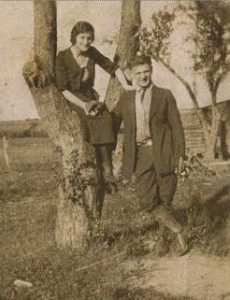 Every family struggles to find ways to do things together…not to mention the time to do so. Kids have their own activities, such as sports, dance, and other club and school activities. Parents work, kids have school, and then there are things that need to be done around the house. By the time dinner is cooked and eaten, and the table cleared, who feels like doing more activities. Plus, there is homework to be done. It seems like there isn’t time for anything more than a television show before bed.
Every family struggles to find ways to do things together…not to mention the time to do so. Kids have their own activities, such as sports, dance, and other club and school activities. Parents work, kids have school, and then there are things that need to be done around the house. By the time dinner is cooked and eaten, and the table cleared, who feels like doing more activities. Plus, there is homework to be done. It seems like there isn’t time for anything more than a television show before bed.
Most of us think this is just something that has come with modern day families, where they barely have time to eat dinner together…if that. In reality, it is a problem that has been around for a lot longer. Kids just naturally grow up and become more independent, and parents get busier too. Something had to be done, so in 1939, so Charles Steinlauf stepped up. He didn’t build his bicycle for a record, because there wasn’t such a thing then. The Guinness book of records didn’t begin until the early 1950’s. Nevertheless, he was some “inventor” to use the word lightly. His was an interesting bicycle, and apparently it held something for everyone…I guess. As odd as it was, the bicycle really  did work. The top rider, namely Charles steered the bicycle with an automobile steering wheel. His wife sat below operating a sewing machine. Their son was in back and their daughter sat on handle bars in front. When they stopped, the legs of the sewing machine kept the two story Goofybike, as it was called, from falling over. I don’t know any other way to safely stop it.
did work. The top rider, namely Charles steered the bicycle with an automobile steering wheel. His wife sat below operating a sewing machine. Their son was in back and their daughter sat on handle bars in front. When they stopped, the legs of the sewing machine kept the two story Goofybike, as it was called, from falling over. I don’t know any other way to safely stop it.
It might have been one of the strangest inventions in history, but, it did get his family out and about in Chicago, Illinois, and I’m certain it also brought them quite a bit of notoriety. I’m sure that there were lots of people who that of Steinlauf as that “weird inventor,” and to be honest, it looks like he just hooked a bunch of odds and ends together. It was, however, a little more technical than that, after all, just hooking a bunch of things together, does not a bicycle make. It has to be able to be ridden in order to really qualify as a bicycle, weird or not. And the Goofybike could be and was ridden by the whole Steinlauf family.
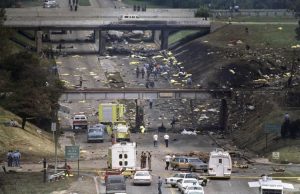 Mistakes happen, but when they are on an airplane, the result is often disastrous. Unless they are terrorists, no pilot wants to make that fatal mistake, because after all, they are on that plane too. Not to mention that they have families of their own that they want to go home to. Still, mistakes do happen, and sometimes they are pilot error, while other times are mechanical failure or even weather.
Mistakes happen, but when they are on an airplane, the result is often disastrous. Unless they are terrorists, no pilot wants to make that fatal mistake, because after all, they are on that plane too. Not to mention that they have families of their own that they want to go home to. Still, mistakes do happen, and sometimes they are pilot error, while other times are mechanical failure or even weather.
On August 16, 1987, Northwest Airlines flight 255 was preparing for takeoff from Detroit Metropolitan Wayne County Airport. The crew began the day, by operating the McDonnell Douglas MD-82 as Northwest Flight 750 from Minneapolis–Saint Paul International Airport. They flew to MBS International Airport in Saginaw, Michigan. They then departed Saginaw, in the same aircraft as Flight 255, flying to John Wayne Airport in Santa Ana, California, with intermediate stops at Detroit Metropolitan Wayne  County Airport in Romulus, Michigan…near Detroit. Their next stop was to be at Phoenix Sky Harbor International Airport in Arizona, but they never made it to Phoenix, crashing instead.
County Airport in Romulus, Michigan…near Detroit. Their next stop was to be at Phoenix Sky Harbor International Airport in Arizona, but they never made it to Phoenix, crashing instead.
The plane’s rate of climb was greatly reduced as a result of the flaps not being extended, and approximately 2,760 feet past the end of runway 3C. The plane’s left wing struck a light pole in a car rental car lot. The impact caused the left wing to start disintegrating and catch fire. The plane rolled 90 degrees to the left, striking the roof of an Avis Car Rental building. The plane was now completely out of control, and crashed inverted onto Middlebelt Road striking vehicles just north of its intersection with Wick Road, killing two people on the ground in a car. It then broke apart…the wreckage skidding across the road, disintegrating and bursting into flames as it hit a railroad overpass and the overpass of eastbound Interstate 94. Of the 149 people onboard, there was one survivor, a four year old girl, who lost her parents and six year old brother in the crash.
 In the end pilot error was blamed for the crash, because the pilots did not run through the pre-flight checklist. There also seemed to be a “problem with electrical power to the takeoff warning system. It was caused by the loss of input 28V dc. electric power between the airplane’s left dc. bus and the CAWS unit. The interruption of the input power to the CAWS occurred at the P-40 circuit breaker. The mode of interruption could not be determined.” The flight number Northwest Airlines 255 was retired, and when Delta purchased Northwest, they continued to honor the retired number. I wondered about retiring a flight number. It seems that in fatal crashes it is customary to retire the number in honor of those lost.
In the end pilot error was blamed for the crash, because the pilots did not run through the pre-flight checklist. There also seemed to be a “problem with electrical power to the takeoff warning system. It was caused by the loss of input 28V dc. electric power between the airplane’s left dc. bus and the CAWS unit. The interruption of the input power to the CAWS occurred at the P-40 circuit breaker. The mode of interruption could not be determined.” The flight number Northwest Airlines 255 was retired, and when Delta purchased Northwest, they continued to honor the retired number. I wondered about retiring a flight number. It seems that in fatal crashes it is customary to retire the number in honor of those lost.

 World War II had dragged on for almost six years, when the United States took things to the next, and as it turns out, final level. For quite some time, Japan had been one of the forces to be reckoned with. Now, with so much new technology, a plan has begun to form to put an end to this war, once and for all. The Japanese had no idea what was coming…how the 6th of August, 1945 would change things forever.
World War II had dragged on for almost six years, when the United States took things to the next, and as it turns out, final level. For quite some time, Japan had been one of the forces to be reckoned with. Now, with so much new technology, a plan has begun to form to put an end to this war, once and for all. The Japanese had no idea what was coming…how the 6th of August, 1945 would change things forever.
That August 6th in 1945 dawned like any other day, but at it’s end, the world would find that everything had changed. The power to destroy whole cities in an instant was in our hands. At 8:16am, an American B-29 bomber dropped the world’s first deployed atomic bomb over the Japanese city of Hiroshima. The ensuing explosion wiped out 90 percent of the city and immediately killed 80,000 people. Tens of thousands more would later die of radiation exposure. Three days later, on August 9, 1945, a second B-29 dropped another  A-bomb on Nagasaki, killing an estimated 40,000 people. With these two events, it was very clear that the nations had the ability to bring mass destruction. Hopefully, they would also have the compassion, not to do it.
A-bomb on Nagasaki, killing an estimated 40,000 people. With these two events, it was very clear that the nations had the ability to bring mass destruction. Hopefully, they would also have the compassion, not to do it.
With such a show of power, Japan’s Emperor Hirohito announced his country’s unconditional surrender to the Japanese people in World War II in a radio address on August 14th, citing the devastating power of “a new and most cruel bomb” as the reason Japan could no longer stand against the Allies. I’m sure the war-ravaged people of Japan were almost relieved. Of course, that meant that they did not know what their future would bring, but the recent past hadn’t been so great either, so they didn’t have too much to lose really.
Japan’s War Council, urged by Emperor Hirohito, submitted a formal declaration of surrender to the Allies, on August 10, but the fighting continued between the Japanese and the Soviets in Manchuria and between the Japanese and the United States in the South Pacific. During that time, a Japanese submarine attacked the Oak Hill, an American landing ship, and the Thomas F. Nickel, an American destroyer, both east of Okinawa. On August 14, when Japanese radio announced that an Imperial Proclamation was coming soon, in which Japan would accept the terms of unconditional surrender drawn up at the Potsdam Conference. The news did not go over well. More than 1,000 Japanese soldiers stormed the Imperial Palace in an attempt to find the 
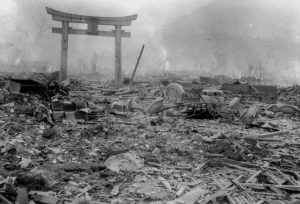 proclamation and prevent its being transmitted to the Allies. Soldiers still loyal to Emperor Hirohito held off the attackers. That evening, General Anami, the member of the War Council most adamant against surrender, committed suicide. His reason was to atone for the Japanese army’s defeat, and he refused to hear his emperor speak the words of surrender. I guess the surrender was not a relief to everyone.
proclamation and prevent its being transmitted to the Allies. Soldiers still loyal to Emperor Hirohito held off the attackers. That evening, General Anami, the member of the War Council most adamant against surrender, committed suicide. His reason was to atone for the Japanese army’s defeat, and he refused to hear his emperor speak the words of surrender. I guess the surrender was not a relief to everyone.
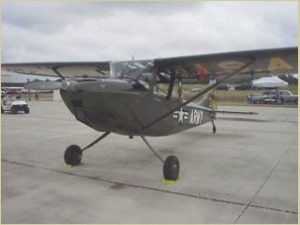 Usually, when a plane crashes, there are signs of the crash, a mayday hail, and the signal from the locator beacon to bring help to the downed plane, to find it’s remains and the people in it, alive or dead, but sometimes circumstances align in such a way, that years can pass by before anyone comes across the wreckage. Such was the case with the August 10, 1984 crash of a Cessna L-19E “Bird Dog” that had gone out to film a particularly nasty type of beetle infestation that had been ravaging hundreds of acres of Colorado forest in and around some of the higher-elevation foothills surrounding some of the Rockies. The Cessna L-19E is a two-seater liaison and observation aircraft built for the US Military. The tandem plane departed Granby (KGNB) for the scenic flight over the Colorado mountains, but never arrived at Jeffco (KBJC) as planned.
Usually, when a plane crashes, there are signs of the crash, a mayday hail, and the signal from the locator beacon to bring help to the downed plane, to find it’s remains and the people in it, alive or dead, but sometimes circumstances align in such a way, that years can pass by before anyone comes across the wreckage. Such was the case with the August 10, 1984 crash of a Cessna L-19E “Bird Dog” that had gone out to film a particularly nasty type of beetle infestation that had been ravaging hundreds of acres of Colorado forest in and around some of the higher-elevation foothills surrounding some of the Rockies. The Cessna L-19E is a two-seater liaison and observation aircraft built for the US Military. The tandem plane departed Granby (KGNB) for the scenic flight over the Colorado mountains, but never arrived at Jeffco (KBJC) as planned.
The pilot, 38 year old James Jeb Caddell had been offered a contract by the Colorado Department of Forestry. That meant that he had mounted a VHS video camcorder on top the instrument panel for the purpose of visually recording any beetle infestation that was observed along the flight route. Caddell, who brought a friend, 38 year old Ronald Hugh Wilmond along for the flight, started the camera shortly after takeoff. It ran until the aircraft crashed down through the trees about 6-1/2 minutes later, documenting the entire trip and the cause of the crash.
Because there was no distress signal, no one knew what had happened, To make matters worse, the aircraft had tumbled into the trees and landed on the Emergency Locator Transmitter, cutting off the signal. Although there was a fire, it burnt out quickly and there was not enough damage to mark the crash site from the air. Searchers tried in vain to find the missing plane, but to no avail. They finally had no choice but to abandon the search. The plane’s wreckage was discovered three years later, when backpackers hiking through the woods found the crash site. At the site was a video tape hanging from tree branches. Incredibly, the video was found to have only minor damage, when the FAA watched it. It had not only survived the crash and subsequent fire, but three years of exposure to the elements, as well.
With nothing else to go on, the video became the primary source data. The NTSB released this accident report. “NTSB Synopsis: Probable Cause: The airplane departed Grandby 8/10/84 and failed to arrive at its destination.  On 8/23/87, it was found on the slope of a high tree-covered ridge. Video tape recovered from the wreckage provided a visual and audio record of the flight from takeoff to impact. Comparing the recording to a topographical map, the flight was climbing and its altitude above the ground was decreasing when it crashed at the 10,200 feet level. During the last few seconds of the tape, the terrain dominated the view through the cockpit window. The pilot made a 60-degree bank, and the stall warning horn could be heard 3 times during approximately 180 degree of turn. the airplane subsequently stalled, flipped over, and entered the trees. The density altitude was about 13,000 feet.
On 8/23/87, it was found on the slope of a high tree-covered ridge. Video tape recovered from the wreckage provided a visual and audio record of the flight from takeoff to impact. Comparing the recording to a topographical map, the flight was climbing and its altitude above the ground was decreasing when it crashed at the 10,200 feet level. During the last few seconds of the tape, the terrain dominated the view through the cockpit window. The pilot made a 60-degree bank, and the stall warning horn could be heard 3 times during approximately 180 degree of turn. the airplane subsequently stalled, flipped over, and entered the trees. The density altitude was about 13,000 feet.
The pilot continued to fly into rising terrain until he was boxed in. He saw the ski slopes which are almost certainly on the leeward side of the mountain: mountain flyers know these can produce a severe downdraft and are trained not to fly straight into them. The pilot presumably panicked because he then compounded his worsening situation with the steep turn to the right. The plane lost lift and the stall warners sounded. The altitude, temperature and humidity combined to create the density altitude of 13,000 feet when the aircraft was actually at 10,200 feet. The high density altitude, flying over Colorado mountains in August, meant that in the turn, the plane was as high as it was capable of flying and was no longer able to climb at speed.
He makes a moderately steep turn to the right (in excess of 45 to 50 degrees angle of bank) in an attempt to turn around quickly – the plane loses considerable lift and initially stalls twice; then on the 3rd stall (with the stall warning horn blaring in the background), enters the traditional “stall/spin” syndrome and flips upside down as the left (up-wing) wing stalls completely and the plane, flipping over on its back, plunges straight down through the trees – but not before capturing the pilot’s last mournful cry to his friend in the back seat: “Damn, hang on Ronnie!!” The plane smashes downwards through the thick tree branches (you can hear the heavy “thuds” as the plane’s wings smash into these while heading for the ground); it crashes and burns – killing both the pilot and back-seat passenger. Improper in-flight planning/decision by the pilot in command and airspeed not maintained are cited by the NTSB report as the probable causes, with the high density altitude and mountainous terrain given as contributing factors.”
The pilot’s family requested that the film not be released to the general public and a 20-year moratorium was placed on the footage. That expired in 2009 and the footage was released. After watching the video, I can say that it was a hard one to watch, because I, unlike the planes occupants, knew what was coming. It seemed to  me, that if he just looked at the terrane coming up ahead of him, he could have made the necessary evasive action to turn around, while there was still time. Unfortunately, he was mesmerized by the view, and only realized his predicament seconds before it was all over. It doesn’t appear that his passenger had any idea that anything was wrong, at least not until Caddell uttered those final words, “Damn, hang on Ronnie!!” Several times during the video, I felt myself pushing back in my seat, as if I could make the plane gain altitude, but when he made that final turn, I felt my stomach lurch, as if I were inside the plane too. A few moments of incredible views, a little bit of inattention, and two lives were over. It was incredibly sad.
me, that if he just looked at the terrane coming up ahead of him, he could have made the necessary evasive action to turn around, while there was still time. Unfortunately, he was mesmerized by the view, and only realized his predicament seconds before it was all over. It doesn’t appear that his passenger had any idea that anything was wrong, at least not until Caddell uttered those final words, “Damn, hang on Ronnie!!” Several times during the video, I felt myself pushing back in my seat, as if I could make the plane gain altitude, but when he made that final turn, I felt my stomach lurch, as if I were inside the plane too. A few moments of incredible views, a little bit of inattention, and two lives were over. It was incredibly sad.
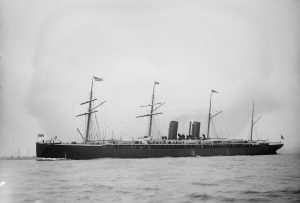 The massive number of ships that sail and have sailed the oceans are mostly safe, but by pure logic, there would also be a number of them for whom safe passage was not to be. For the steamer Alaska, August 8, 1921 would go down in history as the day when her number was up. Shortly after 9:00 pm, the Alaska was sailing south along the California coast, bound for San Francisco, when it hit Blunts Reef…twice. Blunts Reef is located 40 nautical miles south of Eureka, California.
The massive number of ships that sail and have sailed the oceans are mostly safe, but by pure logic, there would also be a number of them for whom safe passage was not to be. For the steamer Alaska, August 8, 1921 would go down in history as the day when her number was up. Shortly after 9:00 pm, the Alaska was sailing south along the California coast, bound for San Francisco, when it hit Blunts Reef…twice. Blunts Reef is located 40 nautical miles south of Eureka, California.
Immediately, the crew knew they were in trouble. Wireless distress signals were flashed. Five miles away the steamer Anyox of Vancouver, British Columbia, Canada picked up the signals…quickly, while disregarding fog and placing themselves in danger of striking the same rocks as the Alaska, put on full speed to the rescue. At 9:30 pm the Anyox received the Alaska‘s final message: “We are sinking by the head.” Before the Anyox could reach the stricken Alaska the ship had sunk, but that was not all that happened to the Alaska.
As the ship sunk, the ship’s boilers exploded…passengers and members of the crew of the steamer Alaska were blown from the decks of the vessel into the ocean. The Anyox, traveling dangerously fast in the foggy night, came upon a lifeboat with survivors from the Alaska. The boat was partially filled with sea water and oily scum. The oil, survivors said, had been thrown over them and into their boat by the explosion of the Alaska‘s boilers, which wrecked the Alaska amidships. The sinking of the Alaska took the lives of 48 of the 214 people on board.
According to the survivors, some of the deaths were caused by the explosion, which threw some passengers and members of the crew into the ocean. Some of those blown into the sea regained the vessel or were saved by clinging to wreckage or finding their way into lifeboats. Others, unfortunately, were either killed or drowned before help came. The Alaska’s sinking came so quickly that all the vessel’s lifeboats could not be deployed. JH Moss and CL Vilin, both of Chicago, said the lifeboat they finally reached had been swept off the decks of the Alaska as the ship settled into the ocean. Other lifeboats, never left their davits and went down with the ship. HS Laughlin of Washington DC, where he worked with the United States Shipping Board, said that a Mr and Mrs Phillips tried for an hour to be taken into a lifeboat after they had been thrown off the Alaska into the water. The survivors all praised the efforts of the officers and crew of the rescue ship Anyox under Captain Snoddy, without whom they would not have been alive.
When the Anyox picked up the first lifeboat and took its passengers aboard Second Officer Andrew Sinclair requested permission from Captain Snoddy to take the Alaska‘s lifeboat and seek survivors in the water who were swimming about and clinging to wreckage. Permission given, three seamen volunteered to accompany 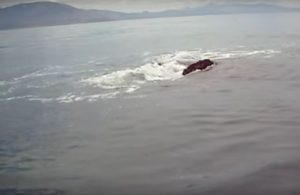 Sinclair. They took the lifeboat and within thirty minutes had rescued thirty persons from the water, rafts, and wreckage, and had put them aboard the Anyox. Captain Harry Hobey of the Alaska, the survivors declared, went down with his ship. Coast Guard vessels Sunday patrolled the waters looking for the wreck. The Coast Guard tugboat, Hanger brought in twelve bodies, all covered with oil. Later fishermen brought five additional bodies to San Francisco. Passengers criticized the Alaska‘s lifeboats. It was said some were not properly manned, had insufficient oars and leaked when put into the water. Nevertheless, those lifeboats had held long enough tp get the complaining passengers to safety. Sometimes, it seems like people forget to be thankful.
Sinclair. They took the lifeboat and within thirty minutes had rescued thirty persons from the water, rafts, and wreckage, and had put them aboard the Anyox. Captain Harry Hobey of the Alaska, the survivors declared, went down with his ship. Coast Guard vessels Sunday patrolled the waters looking for the wreck. The Coast Guard tugboat, Hanger brought in twelve bodies, all covered with oil. Later fishermen brought five additional bodies to San Francisco. Passengers criticized the Alaska‘s lifeboats. It was said some were not properly manned, had insufficient oars and leaked when put into the water. Nevertheless, those lifeboats had held long enough tp get the complaining passengers to safety. Sometimes, it seems like people forget to be thankful.

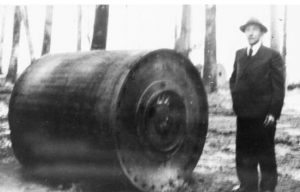 We have all tried our hand at skipping stones across the water, but who would have thought that such an idea could be applied to a bomb, or that it would ultimately become extremely successful in accomplishing its given task…destroying German dams and hydroelectric plants along the Ruhr valley.
We have all tried our hand at skipping stones across the water, but who would have thought that such an idea could be applied to a bomb, or that it would ultimately become extremely successful in accomplishing its given task…destroying German dams and hydroelectric plants along the Ruhr valley.
During World War II, the Allies we’re desperate to cut off energy to the Nazi war machine, so the Allied engineers were given the task of finding a way to breach the defenses surrounding the dams and hydroelectric plants. In the end, it was British engineer, Barnes Wallis who came through with what he called “bouncing bombs.” To watch it in action, one is reminded of skipping stones like most of us have done in the past. In similar fashion, the bomb skips along the water bouncing over the torpedo nets to hit its target.
When World War II began, Germany had the undisputed upper hand when it came to water-based warfare with 
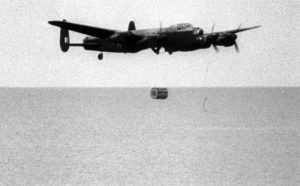 their deadly U-boats and defensive “torpedo nets” placed strategically in front of their energy-creating dams. This made it next to impossible to hit the dams with the traditional torpedo. The British Royal Air Force was determined to take out these German battlements, as they slowly wore the Axis of Evil down.
their deadly U-boats and defensive “torpedo nets” placed strategically in front of their energy-creating dams. This made it next to impossible to hit the dams with the traditional torpedo. The British Royal Air Force was determined to take out these German battlements, as they slowly wore the Axis of Evil down.
The problem was, how to somehow get past the torpedo nets, to destroy the dams and their hydroelectric plants. Wallis had to figure out how to bypass the torpedo nets, in order to make direct contact with the wall of the dams. It seemed like an insurmountable task. After dwelling on the problem for a while, Wallis seized on 
 the potential of the Magnus effect, which would bounce a bomb across the water like a skipping stone.
the potential of the Magnus effect, which would bounce a bomb across the water like a skipping stone.
The theory was to create backspin, which would counter the gravity and send the bomb skimming over the water. Once it bounced over the torpedo net, it hit the designated target. The plan seemed plausible, and the Royal Air Force commenced Operation Chastise on May 16, 1943. The results were spectacular!! As it turned out, Barnes Wallis really knew his stuff.
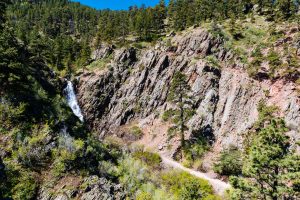
 Those of us who live in Casper, Wyoming know about Garden Creek and Garden Creek Falls. It is a beautiful area, filled with trees and picnic tables. Hiking trails take off from the area, some of which follow the creek. Rotary Park is often full of picnickers and hikers. Everyone is out to have a great time. The Garden Creek area was a much different place in 1891, however. What we know as a day picnic area was a resort area and was lined with camps. A hotel was located at the head of Garden Creek and was a loved summer resort, frequented by local picnic parties. It was frequented by families from near and far.
Those of us who live in Casper, Wyoming know about Garden Creek and Garden Creek Falls. It is a beautiful area, filled with trees and picnic tables. Hiking trails take off from the area, some of which follow the creek. Rotary Park is often full of picnickers and hikers. Everyone is out to have a great time. The Garden Creek area was a much different place in 1891, however. What we know as a day picnic area was a resort area and was lined with camps. A hotel was located at the head of Garden Creek and was a loved summer resort, frequented by local picnic parties. It was frequented by families from near and far.
On, July 31, 1891, a cloudburst occurred over Casper Mountain, right about the area of the head of Garden Creek. The creek is about seven miles long from mouth to source, and it was lined with camps. The heavy rains triggered a flash flood. The swollen creek rushed down the mountainside. The first thing the flood waters reached was the resort at the head of Garden Creek. The buildings were crushed and swept away, and the original site of the hotel was buried beneath wreckage twenty or more feet deep. The rushing floodwaters followed the creek on down the mountain, sweeping away anything in its path. Water marks indicate a volume of water 40 feet high and 495 feet wide must have passed through a narrow area about 2 miles form the mountain proper.
As the water rushed down the side of the mountain, it crashed down upon many campers up and down the creek. Many were either sleeping or just about ready to go to bed for the night. Campers, the Newby family, were sleeping when they suddenly found themselves surrounded by water. Newby heard his wife scream for help, grabbed for her, but missed, and in the next second he found himself being carried off by the rushing water. He never saw his wife or baby son alive again. Newby caught the limbs of a floating tree, He was carried about 200 yards, before he was thrown onto a bank. The body of Mrs Newby was found the next morning beneath a pile of rubble, but the Newby’s baby boy was never found. Near the Newby camp was the camp of Samuel Harrison of Alliance, Nebraska. Harrison’s two children were caught in the flood, and carried away. The bodies of the children were recovered the next morning. The tents and wagons of all the campers up and down the creek were destroyed, and at least fifty persons escaped with nothing but their pajamas. The citizens of Casper quickly stepped forward to bring food, clothing, and comfort to the survivors.


The quick response of the citizens of Casper doesn’t surprise me, because this is a city that often steps up in the face of tragedy. The flooded creek doesn’t surprise me either, because I have seen first hand just how quickly a rain storm on Casper mountain can result in a flood…even in the city proper. All that water has to go somewhere, and Sage Creek near my house is often the recipient of a large portion of that water. Thankfully it quickly drains into the Platte River, and the area returns to normal. Our mostly dry climate helps too, I suppose. The thirsty ground absorbs the water quickly. Still, it shocks me…not that Garden Creek flooded, but more, the vast difference in that area between 1891 and 2019.

